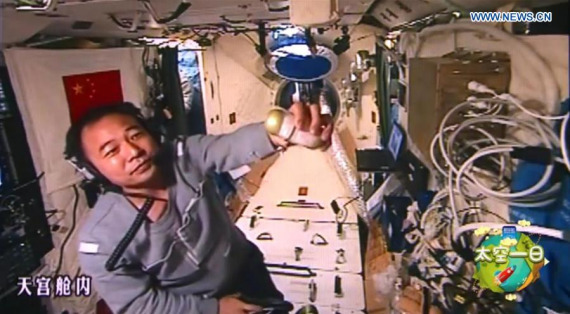
Astronaut Jing Haipeng introduces an installation for sericulture in the space lab Tiangong-2, Nov. 17, 2016.(Photo/Xinhua)
Every morning, we wake up to greetings from Earth and start a new day in space with the same old routine: dressing, washing, brushing teeth, shaving...
We will begin our re-entry journey tomorrow. Today, it's time for a space lesson for Earth's children.
First let's talk about the silkworm experiment designed by middle school students in Hong Kong to study the insect's behavior in microgravity.
Five out of six silkworms taken aboard our Tiangong-2 space lab have cocooned. We've put them in cold containers. The sixth one was not as strong as the others and it didn't move much.
This experiment was supposed to end on Nov. 26, but we didn't give up on the sixth silkworm, we're still taking care of it and observing it.
Reap what you sow. In long-term space travel, how do we get vegetables? The answer is simple: We grow them by ourselves. This is the first time Chinese astronauts have grown crops in space. We grow lettuce this time.
Different from the Earth method of sowing first and watering later, we water a mineral called vermiculite to use as soil and then plant the seeds inside. Vermiculite absorbs a lot of water and then offers it in abundance for our lettuce. The seeds germinated on the fifth day. We were so excited we took some selfies with them.
Then we thinned out the seedlings to ensure that each one of them had enough space for growth. We did it very carefully so as not to hurt them. We also used syringes to inject air into the soil for them to breathe.
I have to say that our lettuce looked especially fresh and even greener than those on Earth, although we only tend to them for 10 minutes each day.
Sadly, our lettuce is only for experimental purposes and not to be eaten, but I believe it will be in the future.
Some kids may wonder why we are testing brain/computer interaction technology in space as we can do it on Earth. There is no consensus on whether the environment in space can affect an electroencephalogram, and our experiment is to try to find out.
The biggest difference between a CDS experiment in space and one on the ground is ultrasound. Under zero gravity our organs are slightly displaced. As a result, organs that are usually easy to find on Earth are much more difficult to locate when in space. We have to be aware of this and adjust the sensors accordingly.
Our space fitness program includes running, cycling and cable exercise, as well as stunts like handstands, somersaults and mid-air tai chi.
At the end of a busy day, we have some free time before going to bed. We take selfies to have some personal record of this unforgettable journey, or just go to the window and quietly stare at that beautiful blue planet called Earth.
It's so beautiful, don't you think?


















































